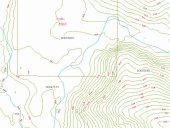posted 12 years ago
My 70 acre property is in a sand/sandy loam/glacial rock region (the rocks are almost all smaller than your fist). I have a ravine running east/west through my property terminating in a 6 acre pond, and on the south side of this ravine (north facing slope), I have several deeply eroded gullies, each with 4-10 acres of drainage feeding it. The property has ~70' elevation drop over 3,000' running west to east. The ground is typically sand/sandy/loam small rocks for 1-4' then red clay below it. It was a 90% loblolly pine forest with some oaks/eastern cedars/hickory scattered in it until about 1.5 years ago when a drought+forest fire (Bastrop Complex Fire) destroyed 95% of all the trees. I heavily seeded it with cover crops which have held most of the soil in place since then. Other parts of my property lack the small rocks and I already have 3,200' of hugelkultur/swales in place there.
I want to start doing water retention projects on this north facing slope and am considering doing a lot of smaller 20-50' swale structures which cascade into each other in the drainage areas.
My question though is concerning the gullies. They range from 150 to 250' in length, with widths starting at 5' ranging up to 70' (at the top) at the outflow to the ravine. Their depths are 20-30' at the ravine from the bank above, with very steep slopes of 45-60 degrees. Today they are shady microclimates, and you see mostly mosses and ferns growing in them.
My thought has been to make multiple dams within the gullies to slow the water down and let it soak in and percolate out over time. The primary challenge I see is that the terrain is not great for equipment given these slopes, and manually doing this is quite daunting! I can see how it might be done with heavy equipment by building equipment travel ways in/out of the ravine at every dam to be built, but I'm hoping to avoid that amount of soil disturbance.
Perhaps Sepp or someone else here has experience with this particular problem and can share their experiences?
Gordon Walton
Dancing Turtles Ranch










